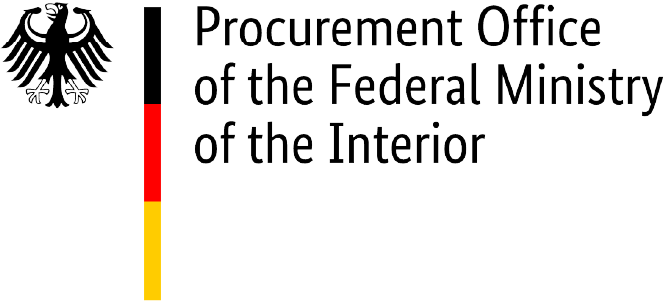Important information: Please note that the federal invoice submission portals, ZRE and OZG-RE, will be consolidated by summer 2025. Following the consolidation, only the OZG-RE will be operated as the sole federal invoice submission portal. The operation of the ZRE will be discontinued as of 31 December 2025. Suppliers will receive all relevant information and the required details for future invoicing directly from the authorities to which they submit invoices. For further details, please refer to this article.
About Peppol and the benefits of using it
This video gives you a brief presentation of the Peppol network, which you can use for e-procurement processes such as submitting e-invoices to the ZRE and OZG-RE submission portals.
Video text: About Peppol and the benefits of using it
Welcome. This video provides information on electronic invoicing in the federal administration. It is published by the Procurement Office of the Federal Ministry of the Interior.
This video will give you a brief overview of the Peppol network, which you can use for e-procurement processes such as submitting e-invoices to the ZRE and OZG-RE federal invoice submission portals.
The Federal Central Invoice Submission Portal (ZRE) can be used by suppliers and service providers to transmit e-invoices to the direct federal administration.
The Online Access Act-compliant Invoice Submission Portal (OZG-RE) can be used to transmit e-invoices to the indirect federal administration and to five of Germany’s federal states.
Information on e-invoicing in Germany’s other federal states is available at https://en.e-rechnung-bund.de/information-on-e-invoicing-in-germanys-federal-states/.
Peppol is the network of the non-profit organisation OpenPeppol, whose aim is to make European and international business transactions more digital and straightforward. The Peppol network enables automated machine-to-machine transmission of e-invoices.
Once Peppol is connected to your ERP system, you can start sending invoices easily with just a few clicks.
This is a quicker, more efficient and more cost-effective way to send invoices. What’s more, sending invoices via Peppol is more reliable than sending them via other channels such as email.
Invoices can be sent via Peppol in compliance with the highest security standards. The transfer of documents from different systems is simplified thanks to a uniform international standard. Your data is not stored in the network itself.
Peppol is the channel used for transmitting e-invoices to the federal administration, enabling you to easily send or import large numbers of invoices.
Are you interested in the technology behind the Peppol network, or would you like to know how easy it is to use Peppol?
Then take a look at the other video tutorials “How does Peppol work?” and “How can I use Peppol?” on our web page https://en.e-rechnung-bund.de/tutorials/. There you will find even more information about the Peppol network.
How does Peppol work?
This video gives you a brief presentation of the technology behind Peppol.
Video text: How does Peppol work?
Welcome. This video provides information on electronic invoicing in the federal administration. It is published by the Procurement Office of the Federal Ministry of the Interior.
This video will give you a brief overview of the technology behind Peppol. Peppol allows you to carry out e-procurement processes, for example transmitting e-invoices to the ZRE and OZG-RE federal invoice submission portals.
The Federal Central Invoice Submission Portal (ZRE) can be used by suppliers and service providers to transmit e-invoices to the direct federal administration.
The Online Access Act-compliant Invoice Submission Portal (OZG-RE) can be used to transmit e-invoices to the indirect federal administration and to five of Germany’s federal states.
Information on e-invoicing in Germany’s other federal states is available at https://en.e-rechnung-bund.de/information-on-e-invoicing-in-germanys-federal-states/.
Please note: This video provides you with background information on the technology behind Peppol, but you do not necessarily need this information in order to use the network. You can easily use Peppol via the federal web service, for example.
More information on this is provided in the video “How can I connect to the Peppol network?”
But let’s first take a look at the technology: The Peppol network is based on a four-corner model. This means there is an invoice sender and an invoice recipient, both of which have their respective Access Points.
The Access Points connect users to the Peppol network and enable documents to be exchanged electronically.
For example, to send an e-invoice, the sender’s Access Point addresses the recipient’s Access Point within the global network. This Access Point then sends the e-invoice to the recipient.
E-invoices sent via these Access Points are secured by digital signatures based on a PKI (Public Key Infrastructure) in order to guarantee security and trustworthiness.
Peppol Participant Identifiers (Peppol IDs) are used to clearly identify recipients in the Peppol network. Similar to IBANs, these IDs are codes which follow a strict schema, in this case defined by Peppol.
You can find the Peppol ID of your invoice recipient in your contract documents or by asking the invoice recipient.
You can also use the Peppol Directory to search for addresses and Peppol IDs of users connected to the Peppol network. The Peppol Directory is available at https://directory.peppol.eu/public.
If you only wish to send invoices, you do not need your own Peppol ID.
Each request from a sender Access Point is sent to an SMP server (Service Metadata Publisher) in the Peppol network.
Information about each recipient’s Access Point is stored here, including the types of document the recipient is able to receive (invoices, orders, etc.) and the recipient’s address to which the documents should be sent.
All of the invoice recipients’ Access Points have their own addresses, which connect them to a central SML server (Server Metadata Locator). There is only one such server in the entire network – a kind of central address database.
After an automated check of which Access Point the recipient is using and whether they are able to receive the type of document in question, the document is transmitted to the recipient.
As a user of Peppol, it is important to note that once you have connected to the network, it is easy to send documents electronically within the network.
The next video, titled “How can I connect to the Peppol network?”, will show the different ways to connect to the network.
How can I connect to the Peppol network?
This video gives you, the invoice sender, a brief presentation on how to use Peppol to carry out e-procurement processes such as submitting e-invoices to the ZRE and OZG-RE submission portals.
Video text: How can I connect to the Peppol network?
Welcome. This video provides information on electronic invoicing in the federal administration. It is published by the Procurement Office of the Federal Ministry of the Interior.
This video will give you a brief overview of the Peppol network, which you can use for e-procurement processes such as submitting e-invoices to the ZRE and OZG-RE federal invoice submission portals. The Federal Central Invoice Submission Portal (ZRE) can be used by suppliers and service providers to transmit e-invoices to the direct federal administration.
The Online Access Act-compliant Invoice Submission Portal (OZG-RE) can be used to transmit e-invoices to the indirect federal administration and to five of Germany’s federal states.
Information on e-invoicing in Germany’s other federal states is available at https://en.e-rechnung-bund.de/information-on-e-invoicing-in-germanys-federal-states/.
In order to use Peppol, your systems need to be connected to one of the network’s Access Points. There are three ways to do this:
- You can use the federal web service if you wish to send your e-invoice via Peppol to German federal authorities or to the cooperating federal states of Berlin, Brandenburg, Mecklenburg-Western Pomerania, Saxony and Thuringia. You can use the web service free of charge and operate it comfortably from your own systems. If you are interested in using this service, please send an email to peppol.support@nortal.com. We will be happy to answer any questions you may have about e-invoicing.
- You can select a Peppol service provider who can provide you with an Access Point. The costs for set-up and use vary depending on the provider. This option allows you to send other documents as well as e-invoices to any user in the Peppol network. If you have any questions about this, please contact a service provider. Feel free to contact us if you have any questions about e-invoicing. A list of service providers can be found at https://www.peppol.org/members.
- You can set up and operate your own Access Point. As an operator, you have control over how to best integrate the Access Point into your own IT landscape and you can also use the Access Point commercially as a service provider. Before doing this, we recommend finding out how difficult it will be to implement and whether your IT system landscape is properly equipped. As well as the costs for developers, there are also fees for becoming a member of OpenPeppol and for operating the Access Point. For more details visit https://www.peppol.org/join/?registration.
Once you are connected to the Peppol network, you can reach all active users within the network – no matter what Access Point they are connected to.
For more details visit https://en.e-rechnung-bund.de/peppol-for-the-federal-administration/.

